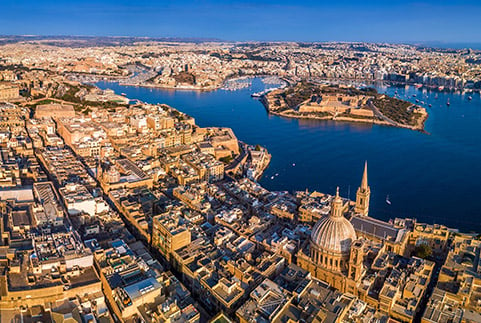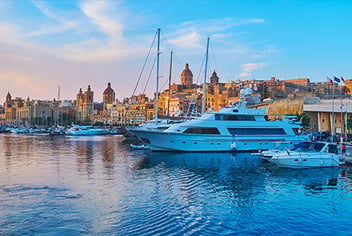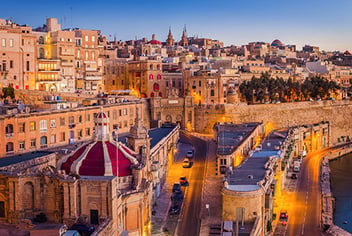Malta Cost of Living 2025: How Much Does It Really Cost to Live Here?
In a time where the cost of living seems to be perpetually on the rise, many individuals, including digital nomads, investors, and retirees, are seeking out destinations where they can get more value for their money.
If you are looking to explore and expand your options and possibilities, take a closer look into the picturesque Mediterranean archipelago of Malta. Blessed with sunny weather, rich history, and relatively affordable lifestyle, Malta presents an attractive option for budget-conscious travellers looking to escape the escalating expenses of North America.
Besides, being a full-fledged EU Member, Malta boasts a robust economy, stable political and social scene, and thriving business environment, making it a hotspot for foreign investment.
But what’s the financial reality of living here? Whether you’re eyeing a business venture or considering Maltese citizenship or Permanent Residency, we’ve got all the facts and figures you need to know, right here.
Housing and Utilities
 Despite its compact size, Malta offers a variety of housing options, ranging from charming apartments to luxurious penthouses. Rental prices are influenced by factors like location, amenities, and square footage. In highly sought-after areas such as Valletta, Sliema, and St. Julian’s, apartment living reigns supreme, with a one-bedroom apartment typically renting for an average of €800 - €850 per month. Moving slightly away from the centre, you can find similar properties for around €650 - €700 a month. Opting for a 2 bedroom apartment will cost you around €1,000, while three-bedroom units typically start at €1,300 and go higher. As for high-end rentals like villas, prices might start from €1,400 per week, but it all depends on the location you’re eyeing and of course the time of year. Additionally, utilities for an 85-square meter apartment typically amount to approximately €80 monthly.
Despite its compact size, Malta offers a variety of housing options, ranging from charming apartments to luxurious penthouses. Rental prices are influenced by factors like location, amenities, and square footage. In highly sought-after areas such as Valletta, Sliema, and St. Julian’s, apartment living reigns supreme, with a one-bedroom apartment typically renting for an average of €800 - €850 per month. Moving slightly away from the centre, you can find similar properties for around €650 - €700 a month. Opting for a 2 bedroom apartment will cost you around €1,000, while three-bedroom units typically start at €1,300 and go higher. As for high-end rentals like villas, prices might start from €1,400 per week, but it all depends on the location you’re eyeing and of course the time of year. Additionally, utilities for an 85-square meter apartment typically amount to approximately €80 monthly.
Overall, both housing and utility costs are significantly lower than the US average.
Food
Malta boasts a vibrant culinary scene, with approximately 90% of potatoes being exported, contributing significantly to our economy. Additionally, being an EU member, Malta enjoys tariff-free trade, helping to maintain relatively affordable food prices. While imported goods may come with a higher price tag, locally sourced essentials like eggs, milk, and bread remain budget-friendly.
For the fish-lovers out there, it’s worth noting that the fishing industry in Malta is crucial to its economy despite challenges like low productivity and underinvestment. Interestingly, tuna and dolphin fish fisheries account for over 65 percent of annual landings, with main fishing ports located at Marsaxlokk Harbour and Mġarr Harbour. EU accession offers opportunities for funding fleet modernisation and sustainable practices. Additionally, the Fisheries Management Zone around the Maltese Islands supports local fisheries resources and sustains the industry.
Thrifty shoppers can find significant savings by exploring the island’s markets, where fresh produce and seafood are competitively priced. On average, a weekly grocery bill for a single person consuming a healthy diet totals approximately €100, though this figure may vary depending on individual preferences.
Dining out is equally wallet-friendly, with local eateries dishing up hearty meals and beverages at reasonable prices. Think €15 for an inexpensive restaurant meal, or €30 for something mid-range, with higher-end establishments offering a wider price range. And the variety of restaurants in Malta is endless, spanning cuisines such as Maltese, Italian, French, Middle Eastern, Asian, and American.
Takeaway options are also readily available, costing around €10 per person—including a soda. Prices vary between €6 and €20 depending on the restaurant, but plenty of joints deliver straight to your door via handy apps. In terms of beverages, your morning cappuccino will set you back around €2.20, or about €66 a month if you're sipping daily. Compared to the US, where a cappuccino may cost around $4.50, Malta presents a more affordable option.
In terms of beverages, your morning cappuccino will set you back around €2.20, or about €66 a month if you're sipping daily. Compared to the US, where a cappuccino may cost around $4.50, Malta presents a more affordable option.
Beer is on the cheap side too, at around €3.00 a pint. A monthly beer budget will amount to approximately €36 if you're hitting the pub once a week—way cheaper than stateside prices, where a local beer may cost around $5.20.
Besides, Malta has its own good quality wines, alongside imports from the region’s finest vineyards. In a mid-priced restaurant, a bottle of good-quality wine typically costs around €20.00.
Transportation
In contrast to mainland Europe, Malta's transportation infrastructure is primarily reliant on road networks, with private transportation being a popular choice. Gasoline prices are around €1.40 per litre but given Malta's compact size, opting for private transportation remains a cost-effective option for many. Filling up a tank may require budgeting around €70, whereas diesel is priced at approximately €1.21 per litre. Additionally, Malta's government offers strong incentives for owning an electric car, including grants, which can significantly reduce the cost of ownership. The island also boasts several car charging stations, promoting the use of environmentally-friendly vehicles.
Public buses and ferries offer convenient rides too, starting at €2.50 during the day and €3 at night. Plus, weekly or monthly passes make the deal even sweeter.
And for those who prefer to keep on working while on their way, taxis are also readily available with rates starting at around €2.50 for the first 1km. This provides an efficient and economical alternative to owning a car. There are several service providers to choose from, including well-known international services like Uber and Bolt, alongside eCabs, a leading local taxi service provider.
Car rentals also offer further flexibility, with daily rates starting from around €15.
Health and Fitness
Malta's healthcare system, comprising both public and private sectors, offers top-notch medical services at a fraction of the cost compared to the United States. Accessing healthcare is easy, with numerous medical centres spread across the archipelago. While public hospitals are efficient and modern, visiting a private doctor may cost you anything between €20 for a GP visit to €50 - €60 for a specialist.
And when it comes to staying fit, you’ve got plenty of options too. Gyms are dotted all over Malta, some even offering cool extras like spas, saunas, and swimming pools. Expect to pay about €50 a month for a standard gym membership in a central area.
Entertainment
 As for leisure activities, Malta’s beautiful weather makes outdoor fun a breeze for most of the year, and it won’t cost you a dime. With its stunning coastline and numerous beaches, ranging from golden sands to pristine white shores, along with limestone swimming spots, there's no shortage of natural beauty to explore. Hiking trails crisscross cliffs, limestone formations, and caves, offering both easy strolls and challenging treks away from the bustling harbour areas.
As for leisure activities, Malta’s beautiful weather makes outdoor fun a breeze for most of the year, and it won’t cost you a dime. With its stunning coastline and numerous beaches, ranging from golden sands to pristine white shores, along with limestone swimming spots, there's no shortage of natural beauty to explore. Hiking trails crisscross cliffs, limestone formations, and caves, offering both easy strolls and challenging treks away from the bustling harbour areas.
Joining clubs and meeting fellow expats is another great way to enjoy your free time without breaking the bank. Valletta, Malta’s capital, boasts an impressive density of restaurants per square kilometre, offering a global culinary experience that will definitely appeal to lovers of fine dining and Michelin-starred restaurants.
Living in Malta also makes it easy to explore neighbouring Gozo, whether for a day trip or an overnight stay. Ferry travel costs less than €2.50 for foot passengers and €20 for cars, with crossings taking around 25 minutes and running regularly throughout the day and night. For a different perspective of the islands, consider renting quad bikes, with prices starting from around €70 for the day.
Cinemas are a popular entertainment option in Malta, with tickets typically priced at €6. Furthermore, as an island nation, boat trips are a hit among locals and visitors alike, with harbour cruises starting from around €7 from Marsaxlokk to Kalanka Bay in Delimara and going up to €36 if you opt to travel all the way to Comino’s Blue Lagoon—an unmissable attraction you should visit at least once. Additionally, the ferry service in The Three Cities provides an affordable option for exploring the area.
In a nutshell, Malta offers a bang for your buck like nowhere else. With its blend of affordability, beauty, and quality of life, it's the Mediterranean gem you've been dreaming of!
Contact DZ Advisory to explore more about Malta, and get in touch. One of our team members shall be in touch to guide you through Malta's Residency programmes.
Q&A Section about the Cost of Living in Malta in 2025
Part Q&A: Q: Does it cost a lot to live in Malta?
A: That depends on how you live! The cost of living in Malta is lower than in many Western countries, especially the US and UK. However, things like eating out, public transport, and utilities can still add up. To make things better, you can live well without going bankrupt if you plan your spending well.
How much does rent usually cost in Malta?
Question: How much does a one-bedroom flat in the middle of the island, like Sliema or St. Julian's, usually cost each month? You might be able to find something for €650–€950 if you don't mind living farther from the city centre. Villas and flats that are bigger will cost more. flats with three bedrooms start at €1,300.
How much do food items cost in Malta?
A: Groceries in Malta are pretty cheap, especially if you only buy things that are grown or made in Malta. In order to eat healthy, a single person should set aside about €100 per week. Things that are brought in from other countries may cost more, but buying fresh food and seafood at local stores can save you money.
What are the prices of things in Malta?
A: The fees for utilities in a small flat (about 85 square meters) are usually around €80 per month. Gas, water and power are all part of this. You might need to set aside a little more money if you use your air conditioner or heater a lot.
How much does in-country public travel cost?
A: Public transport in Malta is free, if you have a Tallinja card. To benefit from this service, one should register for a personalised Tallinja Card by clicking here. Buses cost €2.50 during the day and €3 at night, so public transport is cheap. You can save even more by getting passes for a week or a month. Another fun and cheap way to get around is to take a ferry. A one-way trip starts at €2.50.
How much does the average worker in Malta get paid?
Once taxes are taken out, the average monthly salary in Malta is between €1,500 and €1,800. Of course, this depends on the business and the amount of experience. If you work in finance or iGaming you can expect to be paid more.
Q: Is Malta’s Health care free?
A: There are both state and private healthcare options in Malta. Residents and EU citizens can get free health care from the government, but you may have to wait longer. Private health care is faster and cheaper. A visit to the doctor costs about €25, and a consultation with an expert costs about €45–€65.
How much does it cost to go to school in Malta?
A: Public schools in Malta are free for Maltese citizens. Tuition at foreign schools can be expensive, ranging from €5,000 to €15,000 per year, depending on the school and grade level. How much does child care cost in Malta?
How much does child care cost in Malta?
A: The cost of child care varies a lot, but nursery or preschool usually costs between €200 and €400 per month. Childcare is free if you work in Malta through a scheme supported by Government. You should check with your company to see if they offer subsidies.
How much does it cost to eat out in Malta?
A: It's not too expensive to eat out. A meal at a cheap restaurant costs about €25, while a meal with three courses at a moderately priced restaurant costs about €35. Expect to pay €10–€15 for a quick meal.
How much do deals for internet and cell phones cost in Malta?
High-speed internet ranges in price from €30 to €50 per month, based on the service company and plan. Mobile plans start at about €10–€15 a month for basic deals. Plans with more features cost €25–€40 a month.
How much does it cost to own a car in Malta?
A: Because Malta is small, it can be cheaper to own a car. A litre of fuel costs about €1.40, and car insurance usually costs between €300 and €600 a year. For maintenance, you should set aside €500 per year, but the exact amount will rely on the make and model.
Q: What are the tax rates in Malta?
A: Malta's income tax rates go from 0% to 35% based on how much money you make. You may qualify for special reduced residency tax plans for expats, so it's a good idea to talk to a tax expert.
What kinds of cheap fun are there in Malta?
A: Hiking, swimming, and visiting the coastline are all free to do outside in Malta because of its beautiful scenery. Tickets to the movies cost about €6, and short-route boat trips start at €7 in terms of costs. Ferries between Gozo and Malta are also cheap; people walking can take them for €2.50 each way.
Is it expensive to live in Malta?
Malta has a pretty cheap way of life compared to many Western countries. It's often cheaper to rent, buy food, and eat out than in places like the US or UK. However, some services, goods brought in from other countries, and private school fees can be pricey. Malta is a good place to live because it is both affordable and has a good standard of life.
How much does it cost to live in Malta?
The cost of living in Malta varies based on how you live, but a single person can expect to pay around €1,200 to €1,500 a month, rent included. This covers things like rent, food, utilities, transportation, and fun things to do. The average monthly cost for a family of four is between €2,800 and €3,500, rent included. You can save money by choosing places outside of big towns that are less expensive.
What is Malta's Cost of Living Per Month?
Here are some of the monthly costs that a single person in Malta usually has:
- A one-bedroom flat in the city centre costs €800 to €850 per month to rent.
- Food: €350 to €400 - Utilities: €80 - Transportation: €50 to €100 (gasoline or public transit)
- Eating out: €100 to €150 - Other things: €100 to €150
- For a couple or family, change these numbers to reflect living costs and other costs, such as school or child care.





